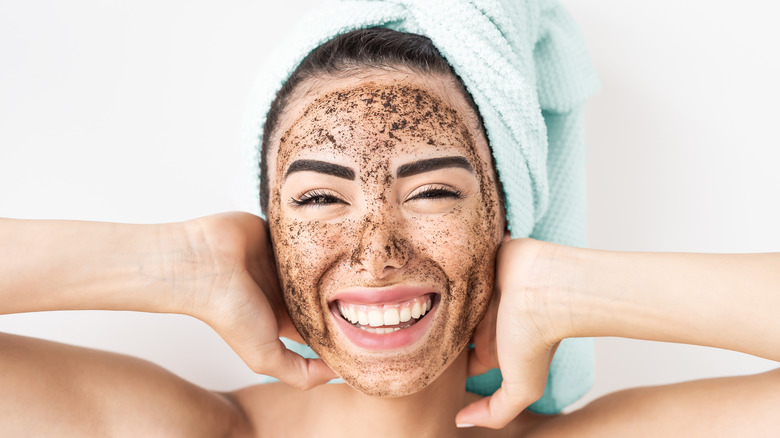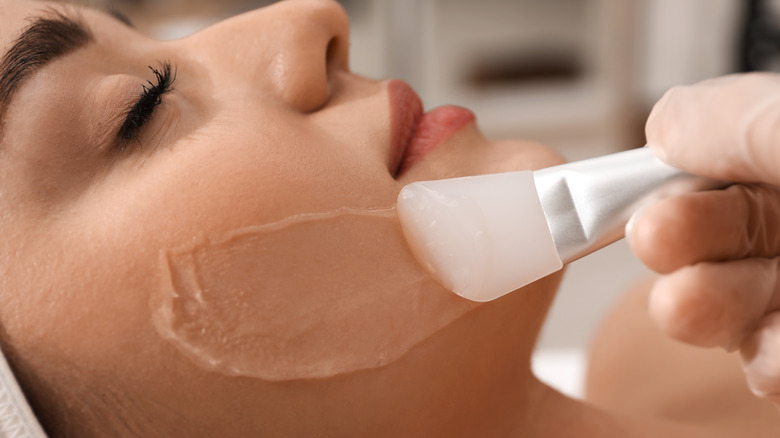How To Use Exfoliation To Even Out Your Skin Tone
We may receive a commission on purchases made from links.
More people are investing in their skincare than ever before. The industry is booming, with new companies popping up and established brands creating new products constantly. Skincare as a business niche is expected to grow to $145.82 billion by 2028, according to Fortune Business Insights. And within such a vast industry, there are products that can treat every kind of skin issue and condition, from acne to fine lines, from uneven tone to texture.
Improving your skin can also help improve the way your makeup looks. Having good skin gives you a base that can help your makeup look flawless, according to Maybelline. When you put your foundation or concealer over even skin tone and texture, it tends to look smoother and make you appear brighter and dewier. But many are also opting to focus on skincare and creating an even complexion so they don't have to rely on wearing a lot of base makeup. And no matter how your skin looks now, you can achieve an even skin tone with the proper exfoliation.
What causes uneven skin tone?
Uneven skin can be due to a variety of issues. It can look like skin discoloration in the form of dark spots or appear textured like dry patches, redness, scars, or acne. In general, an uneven skin tone typically means damage in some way, but the causes can be varied.
According to Dermalogica, environmental factors like sun exposure and pollution can cause dark spots on your face. It's well known that the sun's UV rays can cause damage by producing excess melanin. But UV damage can also darken and deepen other scars or dark spots caused by other factors.
Hormones can also cause melanin production to increase. Taking hormonal birth control, taking some other medications, and becoming pregnant can all lead to excessive melanin that causes dark spots on your skin. Hormonal changes such as these may need to be treated with prescription-strength products.
But one of the biggest causes of uneven skin tone is post-inflammatory hyperpigmentation. Hyperpigmentation is a normal part of the healing process after having acne or a scar. Some acne can also leave behind deeper damage that creates an uneven skin texture. Acne and acne products can lead to dry skin and enlarged pores, which can also contribute to an uneven skin tone.
Exfoliating for better skin
Regular exfoliation is essential to achieve and maintain great skin results. But how often you should exfoliate your skin depends on what type of skin you have. Normal skin can handle exfoliation two or three times a week, according to Riverchase Dermatology. The same can be said for those with combination or oily skin. However, anyone with dry or sensitive skin may want to exfoliate once a week or every other week to prevent irritation.
You'll also want to consider the method of exfoliation: manual versus chemical. Manual uses a product like a scrub or brush to scrape the dead skin cells from the top layers of your skin. However, many dermatologists don't recommend this method for the face because it can be too harsh and ultimately damaging in the long run. On the flip side, chemical exfoliation works in the deeper skin layers, dissolves skin cells, and promotes new cell growth.
Products with ingredients like glycolic acid, lactic acid, and salicylic acid will all chemically exfoliate the skin. Again, you should consider your skin type when choosing an exfoliating acid. "Mild chemical exfoliants are a better choice if you have dry, sensitive, or acne-prone skin because they're gentler than exfoliating scrubs," board-certified dermatologist Annie Gonzalez, MD explains. "Scrubs are easy to overuse and may damage your skin."
Even if you don't have sensitive skin, you'll want to be cautious about using chemical exfoliants, especially if you're new to them. Start slow and give your skin plenty of moisture and hydration to prevent irritation.


